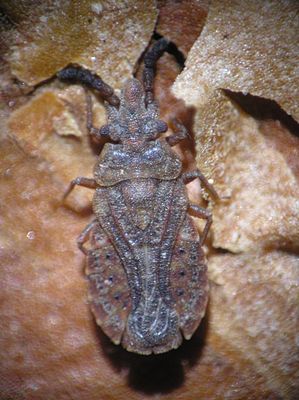Pine bark bug
| Pine bark bug | ||||||||||||
|---|---|---|---|---|---|---|---|---|---|---|---|---|

Pine bark bug ( Aradus cinnamomeus ); male |
||||||||||||
| Systematics | ||||||||||||
|
||||||||||||
| Scientific name | ||||||||||||
| Aradus cinnamomeus | ||||||||||||
| Tank , 1806 |
The pine bark bug ( Aradus cinnamomeus ) is a type of bug from the family of bark bugs (Aradidae).
features
The bugs are 3.2 to 5.1 millimeters long. The animals are unmistakable due to their uniform red-brown color. Your second and third antennae are roughly the same length. Wing dimorphism can be observed in the species. The females are mostly brachypter and only have scaly wing remnants, but there are also fully winged (macroptere) individuals. However, these are only partially airworthy. The flying males are fully winged, but have narrowed (stenoptere) forewings.
Occurrence and habitat
The species is widespread in Europe from Scandinavia to the northern Mediterranean. In the east, the distribution extends to Siberia and Asia Minor to the Caspian region. The species is common everywhere in Central Europe in the north, and increasingly rare in the south. In Austria it occurs only from the lowlands up to a maximum of 600 meters above sea level.
Way of life
The animals live mainly on pines ( Pinus ) such as z. B. Scots pine ( Pinus sylvestris ), mountain pine ( Pinus mugo ), black pine ( Pinus nigra ) and Weymouth pine ( Pinus strobus ). They are only rarely found on spruce ( Picea ), larch ( Larix ) or juniper ( Juniperus ). The bugs can also be found on two to three year old young trees, on older trees they are usually found in the crown area of the younger branches. They prefer weakened trees.
development
The nymphs and adults live under bark scales of living trees on thinner trunk sections and branches and, unlike many other bark bugs, do not suck on fungi, but on the sap of phloem and xylem . You can find them on the basis of dried resin residues on the bark. Gall-like swellings can also develop on thin branches. The species needs two years to develop in Central Europe and three years in northern Scandinavia. Accordingly, not only the adults but also the nymphs overwinter. The adults lay eggs under bark scales from April to July the following year. The nymphs hatching from it in summer overwinter in the third or fourth instar. The wintering takes place at the trunk foot, more rarely also in the needle litter of the trees. In Scandinavia and Eastern Europe in particular, the animals occasionally appear en masse and can cause damage to trees that can even lead to complete death. The eggs are parasitized by Telenomus aradi ( Hymenoptera , Scelionidae ) .
In parts of its distribution area, one of the generations with reproduction in even or odd years, which results from the two-year cycle, is much more frequent than the other. In Scandinavia, for example, a region in western Finland can be demarcated in which imagines appear almost only in odd years, while east of it and in Sweden the generation of even years dominates, both generations are genetically differentiated.
supporting documents
Individual evidence
- ↑ E. Heiss: Nomenclature changes and differentiation of Aradus crenatus Say, 1831, and Aradus cinnamomeus Panzer, 1806, from Europe and the USA (Insecta: Heteroptera, Aradidae). In: Reports of the Natural Science-Medical Association in Innsbruck , Volume 67, pp. 103-116, 1980. (digitized version )
- ↑ a b c d e Ekkehard Wachmann , Albert Melber, Jürgen Deckert: Bugs. Volume 3: Pentatomomorpha I: Aradoidea (bark bugs), Lygaeoidea (ground bugs, etc.), Pyrrhocoroidea (fire bugs) and Coreoidea (edge bugs, etc.). (= The animal world of Germany and the adjacent parts of the sea according to their characteristics and their way of life . 78th part). Goecke & Evers, Keltern 2007, ISBN 978-3-937783-29-1 , p. 15 .
- ↑ Aneurus cinnamomeus. British Bugs, accessed December 29, 2013 .
- ↑ K. Heliövaara, R. Väisänen, J. Hantula, J. Lokki, A, Saura (1988): Genetic differentiation in sympatric but temporally isolated pine bark bugs, Aradus cinnamomeus (Heteroptera). Hereditas 109: 29-36. doi : 10.1111 / j.1601-5223.1988.tb00178.x
literature
- Ekkehard Wachmann , Albert Melber, Jürgen Deckert: Bugs. Volume 3: Pentatomomorpha I: Aradoidea (bark bugs), Lygaeoidea (ground bugs, etc.), Pyrrhocoroidea (fire bugs) and Coreoidea (edge bugs, etc.). (= The animal world of Germany and the adjacent parts of the sea according to their characteristics and their way of life . 78th part). Goecke & Evers, Keltern 2007, ISBN 978-3-937783-29-1 .
Web links
- Aradus cinnamomeus at Fauna Europaea. Retrieved December 29, 2013
